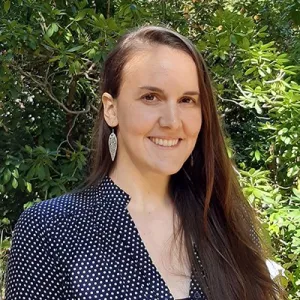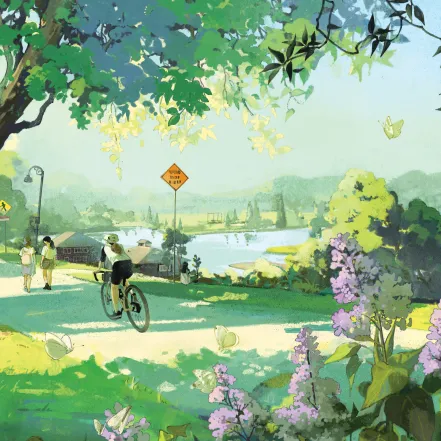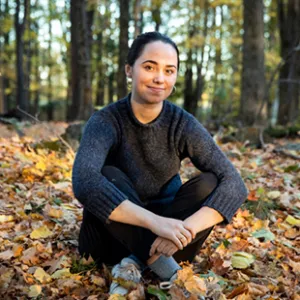
Landscape Studies
Examine the relationship of people to natural and built environments by studying landscapes, from parks and palaces to sidewalks and backyards. The Landscape Studies Program at Smith, the first in a liberal arts undergraduate college in the United States, joins architecture, landscape architecture, landscape history and theory, art, art history and literature with the sciences and social sciences to investigate critical issues in the built environment.
Requirements & Courses
Landscape Studies Minor
Six courses (24 credits)
- One introductory course: LSS 105, FYS 141, FYS 151, LSS 100 and LSS 200, or LSS 100 taken twice
- One methods course: LSS 245, LSS 250 or LSS 255, or an equivalent methods course approved by the program
- One course in arboriculture, botany, ecology, geomorphology, horticulture or hydrology
- One 300-level seminar or advanced studio course: LSS 300, LSS 315 or ARS 389/ LSS 389
- Two approved electives/related courses
Students are encouraged to identify one of the following focus areas, in consultation with the minor adviser:
- Arts, Literature and the Built Environment
- Cultural Landscapes and Heritage Conservation
- Environmental Planning and Sustainability
- Landscape Architecture and Ecological Design
- Urban Studies and Planning
Courses
LSS 100 Landscape, Environment and Design (2 Credits)
Through readings and a series of lectures by Smith faculty and guests, this course examines the history and influences out of which landscape studies is emerging. The course looks at the relationship of this new field with literary and cultural studies, art, art history, landscape architecture, history, biological and environmental sciences. What is landscape studies? Where does it come from? Why is it important? How does it relate to, for instance, landscape painting and city planning? How does it link political and aesthetic agendas? What is its role in current sustainability debates and initiatives among architects, landscape architects, planners and engineers? Students may take this course twice for credit. S/U only. Arts; Social Science; Historical Studies
Spring
LSS 105 Introduction to Landscape Studies (4 Credits)
This introductory course explores the evolving and interdisciplinary field of landscape studies. Drawing upon a diverse array of disciplinary influences in the social sciences, humanities and design fields, landscape studies is concerned with the complex and multifaceted relationship between human beings and the physical environment. Students in this course learn to critically analyze a wide variety of landscape types from the scale of a small garden to an entire region, as well as to practice different methods of landscape investigation. It is a course designed to change the way one sees the world, providing a fresh look at everyday and extraordinary places alike. Priority given to first-year students, sophomores and LSS minors. Enrollment limited to 30. Arts; Social Science; Historical Studies
Fall
LSS 200 Colloquium: Landscape, Environment, and Design (2 Credits)
LSS 200 is a credit linked colloquium to complement the LSS 100 series. Students will engage with the LSS 100 lectures more deeply via weekly class discussions, writing of synthesis papers, and presentations. LSS 200 is intended to provide interested students with an opportunity to grapple critically with topics raised in LSS 100 lectures and thoughtfully make connections between disparate lectures and their broader academic experiences. Can be taken twice for credit. Corequisite: LSS 100. Enrollment limited to 15. Arts; Social Science
Spring
LSS 220 GIS for Landscape & Urban Studies (4 Credits)
GIS for Landscape & Urban Studies provides a critical lens for understanding landscapes, the built environment, and the complex interplay between geospatial environmental and social concerns with the implicit power of the act of mapping them. Emphasizing bias, equity, and ethics, the course examines how geospatial data informs planning and reflects social justice issues like green space access, housing density, and food insecurity. Students gain technical expertise while critically engaging with the societal impact of mapping. Students use GIS tools like ArcGIS Online, QGIS, and Social Explorer to develop skills in geospatial analysis, data visualization, and cartography. Enrollment limited to 20. Social Science
Fall, Spring, Variable
LSS 230 Urban Landscapes (4 Credits)
Students in this course investigate the production of the built environment and the landscape of cities, focusing on key actors such as neighborhood activists, real estate developers, city officials, and environmentalists, among other advocates and interested parties. Organized thematically and supplemented by readings in urban theory and related fields, the course tackles questions of how urban places are made, why different cities look and feel the way they do, and who shapes the city. Prerequisites: LSS 100 or LSS 105 or equivalent. Enrollment limited to 20. Arts; Social Science; Historical Studies
Fall, Spring, Variable
LSS 240 Cultural Landscapes and Historic Preservation (4 Credits)
Debates over the meaning, interpretation and management of unique, artistic, historic or culturally significant places take center stage in this course. Students consider how and why some landscapes and buildings get preserved and protected while others are redesigned, ignored, neglected or demolished. Major themes in the course include continuity and change in the built environment, notions of cultural heritage and the concept of authenticity. Readings include theoretical and historical perspectives on the topic supplemented by case studies and field investigations. Prerequisites: LSS 100 or LSS 105 or equivalent. Enrollment limited to 20. Arts; Social Science; Historical Studies
Spring
LSS 245 Place Frames: Photography As Method In Landscape Studies (4 Credits)
Photography and landscape are intertwined. Scholars, design professionals, artists and journalists use photographs as evidence, as a means of representing sites, as a design tool, as source material for project renderings and as documentation. This course focuses on how photography is a part of field observations and research techniques, how photographs are used in landscape studies and how text and image are combined in different photographic and scholarly genres. Students take photographs and examine the photographs of landscape architects, urbanists, artists and journalists. Field exercises are combined with workshops, discussions and research at the Smith College Museum of Art. Enrollment limited to 15. Arts; Social Science
Fall, Spring, Variable
LSS 250 Studio: Landscape and Narrative (4 Credits)
Landscapes guide their use and reveal their past. This landscape design studio asks students to consider the landscape as a location of evolving cultural and ecological patterns, processes and histories. Students work through a series of site-specific projects that engage with the narrative potential of landscape and critically consider the environment as socially and culturally constructed. A variety of media are used in the design process including drawing, model-making, collage and photography. Priority given to LSS minors and ARU majors. Enrollment limited to 14. Arts; Social Science
Fall, Spring, Variable
LSS 255 Art and Ecology (4 Credits)
Environmental designers are in the unique and challenging position of bridging the science of ecology and the art of place-making. This landscape design studio emphasizes the dual necessity for solutions to ecological problems that are artfully designed and artistic expressions that reveal ecological processes. Beginning with readings, precedent studies and in-depth site analysis, students design a series of projects that explore the potential for melding art and ecology. Enrollment limited to 14. Arts; Social Science
Fall, Spring, Variable
LSS 260 Visual Storytelling: Graphics, Data and Design (4 Credits)
Communicating with images is different than communicating with words. By learning how the eye and brain work together to derive meaning from images, students take perceptual principles and translate them into design principles for effective visual communication. Course lectures, readings and exercises cover graphic design, visual information, information graphics and portfolio design. Students are introduced to graphic design software, online mapping software and develop skills necessary to complete a portfolio of creative work or a visual book showcasing a body or research. Enrollment limited to 18. Arts
Fall, Spring, Variable
LSS 300 Seminar: Rethinking Landscape (4 Credits)
This capstone course in the study of the built environment brings history and theory alive for those students with interests in diverse fields such as art, architecture, American studies, engineering and the natural sciences. Designed as an advanced-level seminar, it explores key concepts and theoretical debates that have shaped the interdisciplinary field of landscape studies. In particular, students investigate how the field has changed over time and critically consider where it is likely to go in the future. Classic texts from thinkers such as J.B. Jackson, Yi-Fu Tuan, John Stilgoe, Anne Spirn and Dolores Hayden are paired with contemporary critiques and new approaches to the study of space and place. Independent research work and participation in class discussion are strongly emphasized. Prerequisite: one 200-level course in LSS, or equivalent. Priority given to LSS minors, and seniors and juniors. Restrictions: Juniors and seniors only. Enrollment limited to 12. Instructor permission required. Arts; Social Science
Fall, Spring, Variable
LSS 315 Seminar:Urban Ecological Design (4 Credits)
This seminar course examines how designers and planners have theorized the interaction of natural processes and human-constructed systems in cities. Major themes include: how planners, architects, landscape architects, and engineers put ecological knowledge and scientific expertise into action to address complex problems; how an ecologically-based reading of the urban landscape differs from typical approaches to city design; relationships between land form, land use, and built environment; and, conceptions of urban nature and “design with nature.” Topics may include sea-level rise; urban infrastructures; access to parks and open spaces; the combined sewer overflow problem; and heat, health, and urban forestry. Restrictions: Juniors and seniors only. Enrollment limited to 12. Instructor permission required. Natural Science; Social Science; Historical Studies
Fall, Spring, Variable
LSS 400 Special Studies (1-4 Credits)
Normally for senior minors. Advanced study and research in landscape studies-related fields. May be taken in conjunction with LSS 300 or as an extension of design work begun during or after a landscape studies or architecture studio. Instructor permission required.
Fall, Spring
Crosslisted Courses
AMS 201 Rethinking America: Introduction to American Studies (4 Credits)
This course provides an introduction to American Studies through the interdisciplinary study of American history, life and culture. Students develop critical tools for analyzing cultural texts (including literature, visual arts, music, fashion, advertising, social media, buildings, objects and bodies) in relation to political, social, economic and environmental contexts. The course examines the influence of race, ethnicity, class, gender, sexuality and transnationality on conceptions of citizenship, and struggles over what it means to be an “American,” and how this has shaped the distribution of power, resources and wellbeing in the United States. WI Historical Studies; Literature
Fall
AMS 202 Methods in American Studies (4 Credits)
This course introduces some of the exciting and innovative approaches to cultural analysis that have emerged over the last three decades. Students apply these methods to a variety of texts and practices (stories, movies, television shows, music, advertisements, clothes, buildings, laws, markets, bodies) in an effort to acquire the tools to become skillful readers of American culture, and to become more critical and aware as scholars and citizens. AMS 201 is recommended but not required. Arts; Historical Studies
Spring
AMS 302 Seminar: The Material Culture of New England, 1630–1860 (4 Credits)
This course examines the material culture of everyday life in New England from the earliest colonial settlements to the Victorian era. It introduces students to the growing body of material culture studies and the ways in which historic landscapes, architecture, furniture, textiles, metalwork, ceramics, foodways and domestic environments are interpreted as cultural documents and as historical evidence. Offered on-site at Historic Deerfield (with transportation available from the Smith campus), the course offers students a unique opportunity to study the museum’s world-famous collections in a hands-on, interactive setting with curators and historians. Utilizing the disciplines of history, art and architectural history, anthropology, and archaeology, students explore the relationships between objects and ideas and the ways in which items of material culture both individually and collectively convey patterns of everyday life. Restrictions: Juniors and seniors only. Enrollment limited to 12. Instructor permission required. Arts; Historical Studies
Spring
ANT 200 Colloquium: Research Methods in Anthropology (4 Credits)
This course introduces students to the variety of methods of inquiry used for research in anthropology. Throughout the semester, students are introduced to methods of locating and analyzing information and sources, developing research questions and writing. Normally taken in the sophomore or junior year. Prerequisite: ANT 130. Restrictions: Anthropology majors only. Enrollment limited to 20. Instructor permission required. Social Science
Fall
ANT 221 Global Archaeology: Method, Theory, and Practice (4 Credits)
This course features case studies from across the globe to explore the diversity of theoretical approaches to studying the past, the field, and lab methods used to analyze material culture, and the ethical considerations of archaeological practice. Students develop a solid foundation for evaluating and contextualizing archaeological research using insights from the humanities, social sciences, and STEM fields. Discussions of global archaeological practice address the roles and responsibilities of archaeologists in global heritage management, museum development, collaborative research with stakeholder groups, and public outreach.
Fall, Spring, Alternate Years
ANT 317 Seminar: The Air We Breathe--An Anthropology of Atmosphere (4 Credits)
From air pollution to atmospheric carbon, from extreme weather events to respiratory viruses, the earth's atmosphere is currently intensely palpable. While these topics are typically the purview of natural scientists, they are also cultural phenomena worthy of anthropological exploration. This seminar explores this contemporary atmospheric moment while situating it in a historical context with readings that provide a multidisciplinary perspective traversing the humanities, social sciences, and natural sciences. Readings draw from anthropology, the history of science, literary studies, climate science, botany, and more. Discussions include wind, breathing, evapotranspiration, climate change, and utopia. Restrictions: Juniors and seniors only. Enrollment limited to 12. Instructor permission required. Natural Science; Social Science
Fall, Spring, Alternate Years
ARS 163 Drawing I (4 Credits)
An introduction to visual experience through a study of the basic elements of drawing. Core studio materials are provided. Students are responsible for the purchase of additional supplies required for individual projects. Enrollment limited to 18. Instructor permission required. Arts
Fall, Spring
ARS 264 Drawing II (4 Credits)
An introduction to more advanced theories and techniques of drawing, including the role of drawing in contemporary art. The emphasis of the class is on both studio work and class discussion. A major topic is the development of independent projects and practice. Students may require additional supplies and are responsible for purchasing them directly. Enrollment limited to 15. Prerequisite: ARS 163 or ARS 172 or equivalent. Instructor permission required. Arts
Fall, Spring, Alternate Years
ARS 266 Painting I (4 Credits)
Various spatial and pictorial concepts are investigated through the oil medium. Core studio materials are provided. Students are responsible for the purchase of additional supplies required for individual projects. Prerequisite: ARS 163 or equivalent. Enrollment limited to 18. Instructor permission required. Arts
Fall, Spring
ARS 280 Introduction to Architectural Design Studio: Analog Processes - Ground (4 Credits)
In nurturing architecture’s foundational principles of visual, material and conceptual experimentation, this course lays the foundation for subsequent studios, lifelong learning and curiosity for architectural design processes. It probes the material, organizational and spatial qualities of the ground, a shared horizontal territory inhabited by plants, people and buildings--one that is as much cultural as it is natural. Through iterative and analog processes, students integrate drawing and making to construct and reconstruct lines in the ground. Probing the physical and conceptual ground for natural or constructed patterns, students develop foundation-level design skills within the context of larger environmental and cultural discourses. Core studio materials are provided. Students are responsible for the purchase of additional supplies required for individual projects. Restrictions: Not open to students who have taken ARS 283. Enrollment limited to 15. Prerequisite: ARH 110 or equivalent. Instructor permission required. Arts
Fall, Spring, Annually
ARS 389/ LSS 389 Broad-Scale Design and Planning Studio (4 Credits)
Offered as LSS 389 and ARS 389. This class is for students who have taken introductory landscape studios and are interested in exploring more sophisticated projects. It is also for architecture and urbanism majors who have a strong interest in landscape architecture or urban design. In a design studio format, the students analyze and propose interventions for the built environment on a broad scale, considering multiple factors (including ecological, economic, political, sociological and historical) in their engagement of the site. The majority of the semester is spent working on one complex project. Students use digital tools as well as traditional design media and physical model building within a liberal arts-based conceptual studio that encourages extensive research and in-depth theoretic inquiry. Previous studio experience and two architecture or landscape studies courses suggested. Priority given to LSS minors and ARU majors. Enrollment limited to 14. Instructor permission required. Arts
Fall, Spring, Variable
ARS 390 Five College Advanced Studio Seminar (4 Credits)
This course is limited to junior and senior art majors from the five colleges. Particular emphasis is placed on thematic development within student work. Sketch book, written self-analysis, and participation in critique sessions is expected. Students may require additional materials and are responsible for purchasing them directly. Offered in rotation within the five colleges. Normally offered at Smith every fifth fall. Three students admitted from each of the five colleges. Prerequisites: selection by faculty; advanced-level ability. Restrictions: Juniors and seniors only; ARS majors only. Enrollment limited to 15. Arts
Fall, Variable
BIO 122 Horticulture: Botany for Gardeners (3 Credits)
Survey course in the fundamentals of botany and horticulture. Plant structure and function, nomenclature, nutrition, seed biology, propagation, growing practices, soils, compost, and an introduction to biotechnology. Discussions include growing fruits, vegetables, and herbs. Course requirements include a field notebook, in-class discussions, independent engagement with written and multimedia resources, and a book review. Corequisite: BIO 123. Enrollment limited to 32. Natural Science
Spring
BIO 123 Horticulture: Botany for Gardeners Laboratory (1 Credit)
Practical lab experiences in plant propagation, morphology, development and physiology, soils, seeds, floral design, and an herbal apothecary. Use of the Lyman Conservatory, and winter and spring observation of outdoor plants are important components of the course. Course requirements include a lab journal and an extended field observation phenology project. Corequisite: BIO 122. Enrollment limited to 16. Natural Science
Spring
BIO 130 Biodiversity, Ecology and Conservation (4 Credits)
Students in this course investigate the origin, nature, and importance of the diversity of life on Earth, key ecological processes, and interactions that create and maintain communities and ecosystems, principal threats to biodiversity, and emerging conservation strategies to protect the elements and processes upon which humans depend. Throughout the semester, the course emphasizes the relevance of diversity and ecological studies in conservation. Concurrent registration in BIO 131 is recommended but not required. Enrollment limited to 69. Natural Science
Fall, Spring
BIO 131 Research in Biodiversity, Ecology, and Conservation (1 Credit)
Students pull on their boots and explore local habitats that may include the Mill River, MacLeish Field Station, Smith campus Botanic Gardens and local hemlock forests. Students gain experience with a diversity of organisms by conducting research projects that can enhance their understanding of ecology and conservation. Students practice the scientific process and document their work in a lab notebook. Research skills developed include hypothesis development, data collection, statistical analysis and presentation of results. Because research projects vary seasonally, please see the Department of Biological Sciences website for more information. Concurrent registration in BIO 130 recommended.Enrollment limited to 16. Natural Science
Fall, Spring
BIO 266 Ecology: Principles and Applications (4 Credits)
This general ecology course provides a conceptual foundation for understanding ecological processes from population dynamics to ecosystem function. Fundamental ecological concepts are covered within the context of current environmental challenges arising from global change. This framing illuminates how population dynamics, community composition and trophic interactions affect ecosystem function and ecosystem services. Corequisite: BIO 267. Prerequisite: BIO 130 or an equivalent course in ecology or environmental science. Enrollment limited to 18. Natural Science
Fall, Variable
BIO 267 Ecology: Principles and Applications Laboratory (1 Credit)
This general ecology laboratory course provides hands-on experience in the execution of ecological experiments in the field. Students participate in study design, data curation, analysis and interpretation. All statistical analyses are conducted in R. Corequisite: BIO 266. Enrollment limited to 18. Natural Science
Fall, Variable
BIO 268 Marine Ecology (3 Credits)
The oceans cover over 75 percent of the Earth and are home to enormous biodiversity. Marine Ecology explores a variety of coastal and oceanic systems, focusing on natural and human-induced factors that affect biodiversity and the ecological balance in marine habitats. Using case studies, the class studies some successful conservation and management strategies, including Marine Protected Areas. This course uses a variety of readings, group activities and short writing assignments to develop vital skills such as effective oral, graphical and written communication; critical thinking; and problem solving. Enrollment limited to 24. Corequisite: BIO 269. Natural Science
Fall
BIO 269 Marine Ecology Laboratory (2 Credits)
The laboratory applies concepts discussed in lecture and uses several small-group projects in the field and laboratory to develop relevant skills for conducting marine-related research. Students learn to design and analyze experiments and to write in the scientific style. Field trips to Rhode Island and Cape Cod, MA provide hands-on experience with marine organisms in their natural habitats. Corequisite: BIO 268. Enrollment limited to 12. Natural Science
Fall
CCX 120 Community-Based Learning: Ethics and Practice (2 Credits)
Service learning, civic engagement, community-based participatory research and community service are familiar terms for describing forms of community-based learning (CBL) in higher education. Theorists and practitioners continue to debate how students and faculty can best join partners to support community-driven goals in areas nearby colleges and universities. Students consider these issues through exploring the literature of community engagement and learning from the experiences of those who practice its different forms. CCX 120 serves as a gateway course for the Community Engagement and Social Change Concentration. Students are introduced to the varied opportunities available at the college for engaging with communities. S/U only.
Fall
DAN 339 Movement, Ecology and Performance in the Smith Landscape (4 Credits)
This course offers an opportunity to explore how place and landscape offer inspiration and opportunities for dance, performance and embodied experience. Place can include natural landscapes, buildings, parks, pathways, stairways, living rooms and the place of bodies. The goal of this course is to create bridges between the ecological and the poetic realms of human experience. Students explore how creativity is being in relationship to things, beings, environments and the historical and cultural contexts. This course includes a series of public performances and is open to students interested in engaging in creative collaborative process. Enrollment limited to 18. Arts
Spring, Alternate Years
ECO 224 Environmental Economics (4 Credits)
The economic causes of environmental degradation and the role that markets can play in both causing and solving pollution and resource allocation problems. Topics include resource allocation and sustainability, cost-benefit analysis, pollution standards, taxes, permits, public goods and common property resources. Enrollment limited to 40. Prerequisite: ECO 150. Enrollment limited to 40. Social Science
Fall, Spring, Variable
ECO 324nr Seminar: Topics in the Economics of the Environment-Natural Resources (4 Credits)
How do competitive markets allocate natural resources? Do market systems result in excess pollution? Can market outcomes be improved in relation to the environment and natural resources? If so, what are the relative strengths and weaknesses of different approaches? This course examines these issues through discussion of the economic theories of externalities, common property and public goods, and their implications for the allocation of resources. The course explores these questions by analyzing specific policy issues and debates related to the environment and resource use including: climate change, pollution, biodiversity, energy, sustainability, land use and fishing rights. Through this exploration, the course touches upon a number of other theories and techniques including dynamic optimization and intertemporal choice, price vs. quantity regulation, nonmarket valuation, cost-benefit analysis and the use of incentive-based regulation. Prerequisites: ECO 250 and (ECO 220, SDS 201, SDS 210, SDS 220 or SDS 291). Restrictions: Juniors and seniors only. Enrollment limited to 12. Instructor permission required. Social Science
Fall, Spring, Variable
EGR 100ee Topics: Engineering for Everyone-Energy and the Environment (4 Credits)
Through readings, discussion, labs and lectures, students learn about human activity related to energy usage and the consequences to Earth’s environment. This knowledge is applied to motivate, design and build scale models of net-zero energy buildings. Through simple lab exercises, students learn to program microcontrollers that measure temperatures and control features within their model buildings, and corresponding analyses enable students to demonstrate how energy from the sun can be utilized in design to reduce carbon-based energy sources. Restrictions: EGR 100 may not be repeated. Enrollment limited to 20. Natural Science
Fall, Spring, Variable
EGR 315 Seminar: Ecohydrology (4 Credits)
This seminar focuses on the measurement and modeling of hydrologic processes and their interplay with ecosystems. Material includes the statistical and mathematical representation of infiltration, evapotranspiration, plant uptake and runoff over a range of scales (plot to watershed). The course addresses characterization of the temporal and spatial variability of environmental parameters and representation of the processes. The course introduces students to the Pioneer Valley, the cloud forests of Costa Rica and African savannas. Prerequisite: MTH 112 and SDS 201, SDS 210, SDS 220 or MTH 246. Restrictions: Juniors and seniors only; Engineering majors only. Enrollment limited to 12.
Fall, Spring, Variable
ENG 199 Methods of Literary Study (4 Credits)
This course teaches the skills to read literature with understanding and pleasure. By studying examples from a variety of periods and places, students learn how poetry, prose fiction and drama work, how to interpret them and how to make use of interpretations by others. This course seeks to produce perceptive readers well equipped to take on complex texts. This gateway course for prospective English majors is not recommended for students simply seeking a writing intensive course. Readings in different sections vary, but all involve active discussion and frequent writing. Enrollment limited to 20. WI Literature
Fall, Spring
ENG 238 What Jane Austen Read: The 18th-Century Novel (4 Credits)
A study of novels written in England from Aphra Behn to Jane Austen and Walter Scott (1688-1814). Emphasis on the novelists’ narrative models and choices; the course concludes by reading several novels by Austen-including one she wrote when 13 years old. Literature
Fall, Spring, Alternate Years
ENV 101 Sustainability and Social-Ecological Systems (4 Credits)
Earth has entered a new geological epoch, the Anthropocene, characterized by the accelerating impact of human activities on the Earth’s ecosystems. All over the globe, humans have transformed the environment and have sometimes created catastrophic dynamics within social-ecological systems. Scientists have studied these phenomena for decades, alerting both the general public and policy-makers of the consequences of human actions. However, despite convincing evidence of environmental degradation, humans continue to radically transform their environment. This course explores this puzzle and asks how social-ecological systems can be remodeled to build a more sustainable and resilient future. Enrollment limited to 50. Natural Science; Social Science; Historical Studies
Fall, Spring
ENV 150/ GEO 150 Mapping our World: An Introduction to Geographic Information Systems (4 Credits)
Offered as GEO 150 and ENV 150. A geographic information system (GIS) enables data and maps to be overlain, queried and visualized in order to solve problems in many diverse fields. This course provides an introduction to the fundamental elements of GIS and applies the analysis of spatial data to issues in geoscience, environmental science and public policy. Students gain expertise in ArcGIS--the industry standard GIS software--and online mapping platforms, and carry out semester-long projects in partnership with campus offices or local conservation organizations. Enrollment limited to 20. Natural Science
Fall
FRN 230bl Colloquium: Topics in French Studies- Banlieue Lit (4 Credits)
In this course, students study fiction, memoir, slam poetry and hip-hop authored by residents of France’s multi-ethnic suburbs and housing projects, also known as the "banlieues" and "cités". The class examines the question of whether "banlieue" authors can escape various pressures: to become native informants; to write realistic rather than fantastical novels; to leave the “ghetto”; to denounce the sometimes difficult traditions, religions, neighborhoods and family members that have challenged but also molded them. Often seen as spaces of regression and decay, the "banlieues" nevertheless produce vibrant cultural expressions that beg the question: Is the "banlieue" a mere suburb of French cultural life or more like one of its centers? Basis for the major. Course taught in French. Prerequisite: FRN 220 or equivalent. Restrictions: FRN 230 may not be repeated. Enrollment limited to 18. WI Foreign Language; Literature
Fall, Spring, Variable
FYS 129 Tierra y Vida: Land and the Ecological Imagination in U.S. Latino/a Literature (4 Credits)
Tierra y Vida explores the ecological imagination of U.S. Latinos/as as expressed in narratives from the early 20th to the 21st centuries. Expanding beyond dominant tropes of land/farm worker as the core of Latino/a ecological experience, students consider a range of texts that depict the land as a site of indigenous ecological knowledge; spiritual meaning; and ethnic, racial and gendered belonging. In dialogues between Latino/a writers and theorists students also explore the possibilities of ecological futures rooted in emancipation and liberation as alternatives to ecological imaginaries still fraught with colonial desires. Students in this course participate in a digital atlas and story-mapping project. Restrictions: First years only; students are limited to one first-year seminar. Enrollment limited to 16. WI Literature
Fall, Spring, Variable
FYS 141 Reading, Writing and Placemaking: Landscape Studies (4 Credits)
Landscape studies is the interdisciplinary consideration of how humans view, define and use the land, whether it be a backyard, a moonscape or a national park. How does land become a landscape? How does space become a place? Scientists study and manipulate landscapes as do politicians, builders, hunters, children, artists and writers, among others. In this course, students examine how writers, in particular, participate in placemaking, and how the landscape influences and inhabits literary texts. The course includes some landscape history and theory, visits by people who study landscape from nonliterary angles, and the discovery of how landscape works in texts in transforming and surprising ways. Restrictions: First-years only; students are limited to one first-year seminar. Enrollment limited to 16. WI
Fall, Spring, Variable
FYS 151 Our Mill River (4 Credits)
The Mill River flows through campus and connects the landscapes upstream and downstream of Smith. From its headwaters in Goshen, MA, to its mouth where it joins the Connecticut River on the Northampton/Easthampton line, the Mill River defines a region of communities that are all here as a result of its waters. Students gain important insight into Smith’s context by exploring and reflecting on the natural and cultural landscape of the Mill River. Weekly field experiences are complemented by readings, map work, historical collections, a sampling of local delicacies, guest experts and class discussions. This course is writing intensive and based in field experiences. Restrictions: First years only; students are limited to one first-year seminar. Enrollment limited to 16. WI
Fall, Spring, Variable
GEO 101 Introduction to Earth Processes and History (4 Credits)
Geology is a study of the Earth. In this course, students examine the processes that formed the Earth and that have continued to change the planet during its 4.57 billion year history. In rocks, minerals and the landscape, geologists see puzzles that tell a story about Earth’s past. Students develop their geologic observation skills. The class investigates the origins of minerals and rocks and the dynamic processes that form volcanoes, cause earthquakes, shape landscapes, create natural resources and control the climate—today as well as during the Earth’s past. Students learn to view the Earth with a new perspective and appreciate how the planet is constantly changing, even if at extremely slow rates. Students planning to major in geosciences should take GEO 102 concurrently. Natural Science
Fall
GEO 102 Exploring the Local Geologic Landscape (2 Credits)
The Connecticut Valley region is rich with geologic features that can be reached by a short van ride from Smith. This is a field-based course that explores geology through weekly trips and associated assignments during which students examine evidence for volcanoes, dinosaurs, glaciers, rifting continents, and Himalayan-size mountains in Western Massachusetts. This class, when taken in conjunction with any other 100-level course, can serve as a pathway to the Geoscience major. Preference given to students taking GEO 101 concurrently and students who have previously taken a Geoscience course. Enrollment limited to 17. Natural Science
Fall
GEO 104 Global Climate Change: Exploring the Past, the Present and Options for the Future (4 Credits)
This course provides the basic scientific background on how human activity is altering the planet. The class examines the modern climate system, how it has changed throughout the course of Earth’s history, and how to predict what might happen in the future. Students answer questions such as “What did the planet look like the last time carbon dioxide levels in the atmosphere were this high?” and “What on Earth is geoengineering?”. The goal of this class is to provide the context and scientific understanding needed to address climate change effectively. Natural Science
Fall
GEO 251 Geomorphology (5 Credits)
The study of landforms and their significance in terms of the processes that form them. Selected reference is made to examples in the New England region and the classic landforms of the world. During the first part of the semester laboratories involve learning to use geographic information system (GIS) software to analyze landforms. During the second part of the semester laboratories include field trips to examine landforms in the local area. Prerequisite: GEO 101, GEO 102, GEO 108 or FYS 103. Enrollment limited to 18. Natural Science
Spring
IDP 109 Aerial Imagery and Cinematography (2 Credits)
This course is designed to immerse students in drone avionics, photogrammetry, image processing, surveying/mapping and aerial photography, and videography. The course encourages teamwork, curiosity, critical thinking, perseverance and creativity, as well as collaboration and etiquette regarding fieldwork and community-based research. Students learn practical techniques for acquiring and analyzing aerial data and have an opportunity to improve Smith’s approach to teaching and research with drones. S/U only. Enrollment limited to 12.
Fall, Spring, Variable
IMX 316 Interdisciplinary Making Concentration Capstone (4 Credits)
This interdisciplinary project-based Capstone course for the Interdisciplinary Making Concentration emphasizes the design process as well as critical social theory on the relationships between humans, designed things and the environment. Through hands-on, individual or collaborative making, students learn how to bring an idea from the concept phase to a final project through research, idea generation, prototyping, iterative improvement and end-of-life planning. This learning happens alongside rich class discussions of seminal and contemporary scholarly work on design’s role in shaping the world. Perspectives include philosophy, anthropology, critical psychology, sociology, cognitive science, history, archeology, theater, studio arts, dance, material science, geometry, physics and feminist theory. Prerequisite: IDP 111. Interdisciplinary Making Concentrators only. Enrollment limited to 15. Instructor permission required.
Fall, Spring, Variable
PHI 238 Environmental Philosophy (4 Credits)
This course prepares students to understand and critically evaluate various ethical perspectives on human beings’ interactions with nature and these perspectives’ applications to environmental issues. The principal ethical perspectives studied are anthropocentrism, biocentric individualism, environmental holism and environmental pragmatism. The class studies representative descriptions and defenses of these perspectives and examine in particular whether they can validly and effectively help us resolve environmental problems. Students study controversies about biodiversity, wilderness protection, global climate change and pollution. Enrollment limited to 40. Social Science; Historical Studies
Fall, Spring, Alternate Years
POR 220mb Topics in Portuguese and Brazilian Literature and Culture-Mapping Brazilian Culture onto an Urban Grid (4 Credits)
This course addresses a broad range of urban, social and cultural issues while also strengthening skills in oral expression, reading and writing, through the medium of short stories, essays, articles, images, music and film. In order to promote a hands-on approach to understanding culture, class assignments also encourage students to explore the Brazilian community in Boston. Prerequisite: POR 100Y or POR 125 or the equivalent. Enrollment limited to 18. Foreign Language; Literature
Fall, Spring, Variable
SOC 203 Qualitative Methods (4 Credits)
Qualitative research methods offer a means of gaining insight and understanding into complex perspectives held by people about social practices and social phenomena. Whereas good quantitative research captures scale, good qualitative research reaches the depth of perceptions, views, experiences, behaviors and beliefs. Qualitative research deals with meanings; it seeks to understand not just what people do, but why they choose to do what they do. This course provides students with a theoretical as well as practical grounding in qualitative research including research ethics, research design, practicalities in research, research techniques, data analysis, and theorizing and dissemination of research findings. Prerequisite: SOC 101. Enrollment limited to 35. Social Science
Spring
Additional Programmatic Information
Students study the design, history and politics of landscapes in the United States and abroad. We read histories, theory and literary texts that express the great range of ways in which people inhabit, shape and understand the landscape. In classrooms and in studios, we explore physical landscapes and design working plans.
The Landscape Studies Program links faculty, students and courses in architecture, engineering, and environmental science and policy. Together, these people and programs produce a study of the design, ecology, politics and human relationship to the environment that we believe is unique in the United States.
Smith’s resources make this possible. The campus is a botanic garden and an arboretum, a historic landscape designed by the firm of Frederic Law Olmsted, the creator of Central Park. Smith's museum, libraries, Rare Book Room and the campus itself, together with the curriculum, form a unique, rich archive and laboratory for the study of human interactions with the spaces and places we inhabit.
The Five Colleges—Amherst, Hampshire and Mount Holyoke colleges, and the University of Massachusetts—are collectively a hotbed of academic, artistic and activist involvement with the environment. University professors of landscape architecture and regional planning welcome our students in their courses. Under an agreement between Smith and the Department of Architecture and Landscape Architecture and Regional Planning at the University of Massachusetts, Smith students can choose courses here and at the university that will permit them to receive the professional degrees of master in architecture and master of landscape architecture in two years instead of three.
In addition, our landscape of the Connecticut River Valley is one of the most fertile agricultural landscapes in the country and is a center for innovation in design, recovery and use of the environment.
Additional Course Information
The Speakers Program is a two-credit course in Landscape studies (LSS 100). It is offered as S/NC only and may be taken twice for credit. Three short papers and weekly readings related to the speakers’ topics are required. For more information, email Reid Bertone-Johnson, or Steve Moga.
LSS 100/Speakers Program meets in the Hillyer Art Complex-Graham Hall, from 3:05–4:45 p.m. The Smith College community is welcome to attend.
Additional information will be posted as it becomes available.
The following courses are cross-listed with the Landscape Studies Program minor and count as electives. All courses are not offered every year. Check the Smith College course catalogue for current offerings.
Approved Methods Courses
The following courses meet requirement #2:
- AMS 202 Methods in American Studies
- ANT 200 Research Methods in Anthropology
- ANT 221 Thinking from Things: Method, Theory, and Practice in Archaeology
- ANT 249 Visual Anthropology
- ARH 291 Topics in Art History: Streets
- ARS 163 Drawing I
- ARS 264 Drawing II
- ARS 283 Introduction to Architecture: Site and Space
- ARS 285 Introduction to Architecture
- DAN 339 Movement Ecology
- ENG 238 What Jane Austen Read: The 18th-Century Novel
- ENV 101 Sustainability and Social-Ecological Systems
- ENV 150 Mapping Our World: An Introduction to Geographic Information Systems Same as GEO 150
- FRN 230 Colloquium in French Studies Topics course
“Banlieue Lit” - POR 220 Topics in Portuguese and Brazilian Literature and Culture: Contemporary Cityscapes: Mapping Brazilian Culture Onto an Urban Grid
- SOC 203 Qualitative Methods
Approved Courses in Landscape Sciences
The following courses meet requirement #3:
- BIO 122 Horticulture: Botany for Gardeners
- BIO 123 Horticulture: Botany for Gardeners
- BIO 125 Plants in the Landscape Practicum
- BIO 130 Biodiversity, Ecology and Conservation
- BIO 131 Research in Biodiversity, Ecology, and Conservation
- BIO 266 Ecology: Principles and Applications
- BIO 267 Ecology: Principles and Applications Laboratory
- BIO 268 Marine Ecology
- BIO 269 Marine Ecology Laboratory
- BIO 368 Seminar: Understanding Climate Change through Plant Biology and the Arts
- EGR 100 Engineering for Everyone
Sustainable Water Resources
How We Engineer the Environment
Energy and the Environment - EGR 315 Seminar: Ecohydrology
- GEO 251 Geomorphology
- HST 150 The Historian’s Craft
Approved Seminar or Advanced Studio Courses
The following courses meet requirement #4:
- AMS 302 Seminar: The Material Culture of New England, 1630–1860
- ANT 317 Seminar: The Anthropology of Landscape – Space, Place, Nature
Electives
The following cross-listed courses may also be considered as electives for the LSS minor:
- ANT 135/ ARC 135 Introduction to Archaeology Offered as ANT 135 and ARC 135.
- ANT 224/ ENV 224 Anthropos in the Anthropocene: HumanEnvironment Relations in a Time of Ecological Crisis Offered as ANT 224 and ENV 224.
- ANT 300 Ethnographic Design
- ARH 150 What is Architecture?
- ARS 264 Drawing II
- ARS 380 Architectural Design Studio: Transient Spaces - Terrestrial Bodies
- CCX 120 Community-Based Learning: Ethics and Practice
- CCX 245/ SWG 245 Colloquium: Collective Organizing Offered as SWG 245 and CCX 245.
- ENV 207 Introduction to Environmental History
- ENX 100 Environment and Sustainability: Notes from the Field
- ESS 100 Playing the Game: Introduction to Exercise and Sport Studies
- FRN 230bl Colloquium: Topics in French Studies- Banlieue Lit
- FYS 103 Geology in the Field
- FYS 141 Reading, Writing, and Placemaking: Landscape Studies
- FYS 151 Our Mill River
- GEO 101 Introduction to Earth Processes and History
- GEO 102 Exploring the Local Geologic Landscape
- GEO 104 Global Climate Change: Exploring the Past, the Present and Options for the Future
- GEO 106 Extraordinary Events in the History of Earth, Life and Climate
- GEO 361 Tectonics and Earth History
- IDP 109 Aerial Imagery and Cinematography
- IDP 316 Critical Design Thinking Studio
Faculty
Affiliated Faculty
Fernando Armstrong-Fumero
Associate Professor of Anthropology
Jesse Bellemare
Associate Professor of Biological Sciences
John Berryhill
Director of the Botanic Garden
Alice Hearst
Professor of Government
Barbara Kellum
Professor of Art
Elisa Kim
Assistant Professor of Art
Douglas Lane Patey
Sophia Smith Professor of English Language & Literature
Emeriti
Dean Flower
Professor Emeritus of English Language and Literature
Ann Leone
Professor Emerita of French Studies and of Landscape Studies
A Landscape for Learning
Opportunities & Resources
Students Talk
Contact Department of Landscape Studies
Wright Hall 107
Smith College
Northampton, MA
Phone: 413-585-3414 Email: dosepowi@smith.edu
Director of Landscape Studies: Steven Moga
Administrative Coordinator: David Osepowicz











